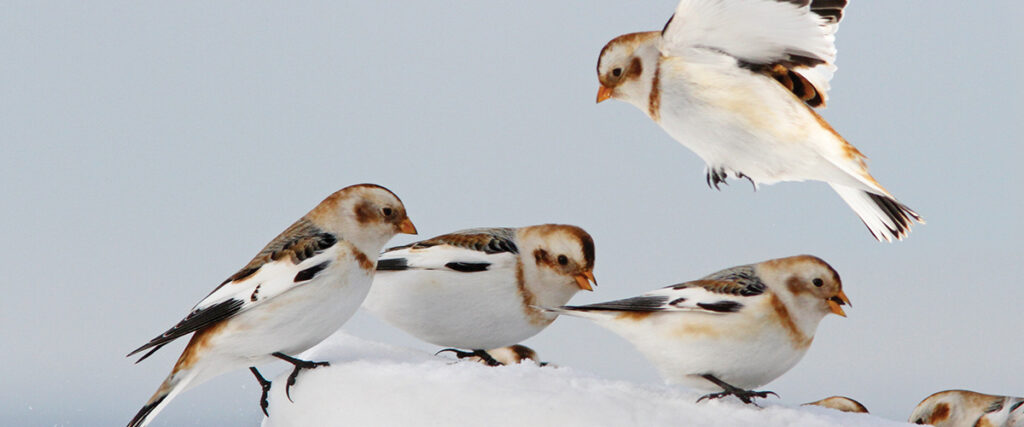Birdwatch

A Rare Winter Visitor
Keep an eye out for the snow bunting
By Susan Campbell
No bird in North America conjures up an image of midwinter like the snow bunting. These open country birds of the North are well adapted to cold and snow, as their name implies. The species is migratory and so may be found in the northern half of the U.S. in winter. Individuals are not at all a common sight this far south. However, they may show up here and there during the colder months. So, it is good to be aware — and know what to look for.
Snow buntings breed in rocky areas on the tundra during the late spring and summer. They nest in crevices between rocks, using moss and down to create a soft cup. In the fall, when temperatures plummet and the days shorten, these birds take off in a southerly direction for more hospitable locations. Typically, they show up in weedy fields and along lakeshores, but they can also be found at the coast on sandy beaches.
These birds typically have more white plumage in the summer — especially the males. This is the result of feather wear (not different feathers) during the cooler months after a post-breeding-season molt. Males are white with black backs, wingtips and tail tips. Females are grayish, but even they have white bellies and flanks. In winter, their plumage contains brownish hues such that they blend in well with the vegetation, as well as the sand or soil in their preferred feeding habitat. They are truly birds of the ground and so are rarely seen perched in trees or on wires. In flight, they are quite distinctive year-round with large white wing patches and white rumps. And if traveling with others, they will produce an array of odd, loud noises: They may rattle, buzz and/or twitter.
Single snow buntings may be easily overlooked. They do not tend to flush until the last second. Between the fact that they are so well camouflaged and that they tend to be silent, they are often missed even at close range. Furthermore, they are not typically found at feeding stations, preferring larger natural areas to backyards.
Although there have been no reports of these special little birds sighted in central North Carolina yet this season, there has been a flock of up to two dozen on the Outer Banks this winter. They have been observed feeding on the seeds of sea oats and other dune grasses since early December on the south side of Oregon Inlet. If you happen to be out that way in the next several weeks, you may be able to find them. Flocks may move around frequently, leapfrogging over one another as they search for their next meal. Simply stroll the dunes watching for movement around the vegetation, and be sure to listen for their raspy calls. The group sticks together by frequently vocalizing. Keep an ear out and you may be rewarded with a glimpse of this rare winter visitor. OH
Susan Campbell would love to hear from you. Feel free to send questions or wildlife observations to susan@ncaves.com.
